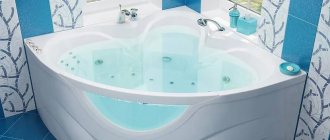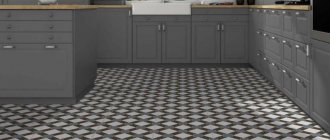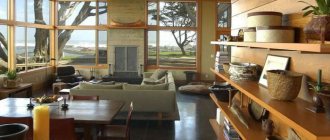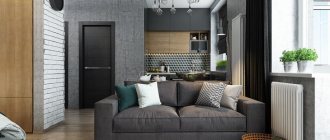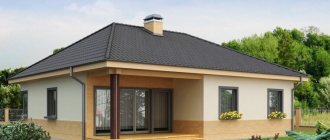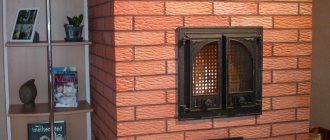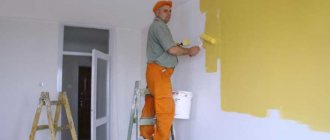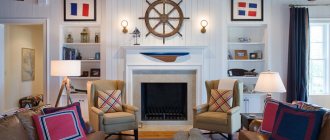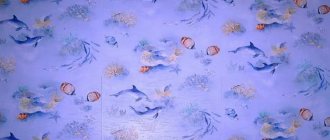The purpose of a kitchen apron is to protect the walls of the room from hot splashes, drops of fat, steam and other things. After all, ordinary plaster, panels, and even more so wallpaper simply will not withstand such exposure. But, in addition, this element can play a significant role in the interior.
A mirrored kitchen splashback undoubtedly best meets the requirements.
General properties
An excellent decoration option would be a mosaic for the kitchen apron. The mosaic canvas consists of individual bright fragments, which is a significant advantage over ordinary tiles.
Various materials are used in production, from mother-of-pearl to natural stone. Therefore, mosaics are easy to match to any style of kitchen - from country to high-tech.
All kinds of shades, interspersed in abundance in the mosaic, allow you to combine together all the colors present in the kitchen. At the same time, it produces a hard and fire-resistant fabric, as a result the kitchen apron area is completely protected. There are no abrasions or minor scratches on it.
In the corridor and hallway
The use of mosaics in the hallway is due not only to decorative considerations, but also to the small area of the premises. Furniture and panels with mosaic elements are appropriate in the corridor. And if you decorate a spacious hall with shining squares, this will favorably emphasize its royal size.
In the living room
The interior of the living room, decorated with mosaics, acquires a special charm.
The photo shows a living room decorated with stripes of mini-mirrors. Such illuminated architectural elements serve a decorative function, unifying the space.
Types of mosaics and methods of fixing them
Modern types of mosaics are made from different materials that differ in operational and decorative characteristics. The following types are used to cover the apron of a working kitchen wall:
- Glass is the oldest facing material. It is distinguished by its spectacular appearance, water resistance, heat resistance, impact resistance and a wide range of colors. Mounted in the form of individual pixels or flexible panels.
- Smalt is a kind of analogue of glass mosaic. The difference between the types lies in the presence of potassium salt in the composition, a different production technology and improved performance characteristics, which are reflected in the price. It is made by grinding glass into powder and baking it again with the addition of dyes. Each pixel has an individual shade, gloss or matte surface. The pattern is formed not by modules, but by the arrangement of individual chips.
- Ceramic - in appearance it is similar to ceramic tiles. Differs in smaller size. In terms of performance, it is superior to glass, but inferior to smalt. Working with it involves pixel styling.
- Stone - made from various rocks, starting with the economical option - tuff, ending with granite or marble. Quality characteristics depend on the material used to make a particular model. Inexpensive compositions are mounted in the form of modules, elite species - only in pixels.
- Metal - the simplest manufacturing option: stamped stainless steel caps, 0.5 mm thick. The surface can remain unchanged or be coated with brass, bronze, matte, or have notches. Produced and installed in the form of modules.
- Economy options - PVC panels, MDF, melamine boards with a mosaic image printed on them. Compared to the materials described earlier, they are inexpensive, but they are no different in practicality. Under constant exposure to aggressive environments, high temperatures, fats, the surface becomes unusable within 2-3 years of existence.
Interesting! Precious metals (gold, platinum) are also used to make mosaics. There are models that are made only using manual labor. Such pixels are most often placed individually, using decorative inserts that accentuate the inclusions.
How to choose mosaic tiles
The roots of mosaics go back centuries. The first mentions of it can be found in ancient manuscripts. Architectural monuments have also been preserved in Ancient Egypt. In particular, the pyramid of Pharaoh Josser is decorated with colorful mosaic tiles. Over the centuries, it has undergone dramatic changes in its production structure.
Ultimately, today it is not the same mosaic that it was before. Modern mosaic tiles are an image of very small square pieces of different shades. It is durable and resistant to mechanical damage.
Today, buying mosaic tiles does not present any difficulties. The assortment amazes with its splendor and outlandish designs. You can purchase sea glass material, mirror tiles, ceramic or stone mosaics.
If previously tiles were only square in shape, modern technologies allow manufacturers to produce rectangular tiles and even round shapes. With such a variety of choices, the master can complete them in a variety of combinations, creating real works of art. You can see this in the photo of mosaic tiles in the kitchen interior.
Tile mosaics include molded ceramic tiles, and therefore have similar properties to tiles - durability, moisture resistance, resistance to temperature changes.
However, ceramic mosaic looks bright and attractive compared to tiles. It gives the impression of exclusive handcraft and fits perfectly into the interior. This happens thanks to small tiles.What to combine mirror mosaic with?
Mirror mosaic is a universal decorative item that looks good in combination with many materials. Most often it is combined with glass or plastic mosaics and ceramic tiles.
The photo shows an elegant combination of light tiles and mirror details that resemble streams of water and add individuality to an ordinary interior.
What do you need to know when choosing mosaic tiles for your backsplash?
The most important thing you should pay attention to when choosing small elements for a small space that is constantly exposed to steam, grease, and chemicals is the material.
In almost all cases, glass or stone is used; from the point of view of reliability and lifespan, this is the golden mean.
In turn, they are divided into several groups:
- Glass is cheap (in most cases it is used for a hut and a pool);
- Regular glass, colored in bulk (an excellent solution in the mid-price range);
- Pressed glass coated with mother-of-pearl or gold plating (also a popular backsplash mosaic for the last few years, which was previously used to decorate shower rooms);
- From stone of various types and textures, as well as with a wide variety of colors;
- A mix of stone and glass is the most impressive type of mosaic for a kitchen backsplash, which varies in price range from 5 to 15 thousand rubles per square meter.
Each of the groups presented above has its own subtleties that the average consumer does not need, but we would like to draw your attention to the most common customer questions and the answers to them.
Most clients are interested in whether there is a difference in goods from different countries of production and factories, in particular the hot question: “Which is better, Italy or China.”
The answer is quite banal - Italian mosaic is better in terms of processing quality (geometry), but the material itself is no different. If you need a kitchen apron without any complaints or the smallest defects, then definitely Italy or Spain, and if the main thing is price/quality, in this case the variety and price of Chinese mosaic tiles will be an excellent choice to purchase.
What should you pay attention to when purchasing such decor?
In order not to make a mistake when choosing mirror tiles, you need to consider several important points. First of all, you should pay attention to the size and thickness of the product. Having decided on these parameters, you need to check the quality of slice processing. In more budget options, the edge is subjected to regular grinding, while in more expensive products, the edges of the segment are carefully polished.
For those who need mirror tiles of the same size, we can recommend choosing the decor already attached to the mesh. From products sold in loose form, you can create almost any ornament. But this is quite painstaking and time-consuming work.
As for color, it all depends solely on the personal preferences of the individual consumer. The most popular products today are white, black, silver and gold.
Mosaic features: pros and cons
The mosaic canvas is made from particles of various materials, which are then applied to a special base. The most popular today are glass and ceramic mosaics; options for using multi-colored stones, smalt, and wood are also possible. Any of these materials allows you to create unique panels that have many advantages, for example:
- A variety of color options, thanks to which you can choose a mosaic apron to match any color of the kitchen, make a transition from the lower tier to the upper tier in a two-color set, or create a bright accent in the room;
- Resistance to any external influences - mosaic has increased moisture and heat resistance, the ability to withstand any chemicals, acids, which makes cleaning easier;
- Possibility of easy restoration in case of damage to the drawing;
- High artistic possibilities - the presence of small fragments allows you to create various decorative designs from a simple pattern or ornament to a complex intricate composition;
- Long service life - mosaic is considered one of the most durable materials, which does not lose its qualities for years, and sometimes decades;
- Suitability of the material for the design of any architectural features: small protrusions, kinks, corners, minor details.
Mosaic design
One of the advantages of the material is its diversity. First of all, this concerns the size of the particles - tesserae that make up the canvas. The smallest ones have dimensions of 1x1 cm, and the largest ones - 10x10 cm - can be compared with ceramic tiles. In addition to square shapes, tesserae can be in the form of rhombuses, triangles, circles or broken elements. Using various combinations you can create a wide variety of masterpieces in your work area.
Like any modern finishing material, mosaic has many colors. In some cases, it even surpasses other types of work area cladding with its colorful combinations and patterns. The most common types of color interpretations include:
- Monocolor. In this case, the mosaic canvas is laid out from elements that have the same size and color. This design is perfect for modern interiors in the spirit of minimalism, as well as those oversaturated with bright colors.
- Gradient. A distinctive feature is rectangular tesserae, which seem to be stretched along the working surface. The flow of shades creates original visual effects, expanding or raising the plane of the apron.
- Mix. To decorate the apron, one leading color and several of its halftones are selected; there may be neutral white and black splashes to create a pattern. A kitchen apron in this design will become a significant decoration of the room in any style, if you choose the dominant tone correctly. It will bring some dynamics and “stir up” the boring laconicism of the interior.
- Panel. An excellent option for connoisseurs of paintings and patterns. A mosaic is a ready-made set of matrices that make up a specific image. This type of finishing requires leisurely installation, but this drawback is fully justified by its excellent appearance.
It should be noted that their cost often depends on the choice of the number and brightness of colors of mosaic matrices. The most economical option is monocolor, the production technology of which is not as complicated as in other options, for example, in the case of panels.
If you want to simplify the process of decorating a mosaic without bothering with the painstaking installation of each individual element, you can choose the most suitable type of mosaic matrix. There are several types, which differ in the principle of connecting tesserae and fastening to the surface. The most convenient installation method is for panels based on a polymer mesh. In terms of time spent on work and consumption of adhesive, this is the most economical option. In addition, the mesh is a kind of reinforcement that prevents the elements from falling apart.
There are matrices on a paper basis, onto which the tesserae are glued with the front side. After gluing the mosaic onto the apron, the paper is simply removed.
Self-adhesive panels are similar to double-sided tape; installation does not require additional adhesive. Such canvases are perfectly fixed to plastic and glass surfaces of the apron, but are completely unsuitable for plastered surfaces.
There are also matrices with polymer bridges that are removed during the installation process. However, such connections are recognized as unreliable, so such matrices are not in great demand.
What are mirror tiles made of?
The essence of the cladding is that the surface is laid out from small pieces of mirror. The shape of the fragments can be the same or arbitrary.
Mosaic comes in different types:
- Small format tiles. In construction stores you can often find tiles in the 5x5 format. She is very popular.
- Homemade mosaic. Broken tiles do not have to be thrown away. Scraps of different colors and textures are suitable for creating original and unique cladding. Pieces of ceramics, broken glass, mirror particles, flat stones, pebbles - these are some of the components of such a DIY mosaic.
- Mirror mosaic on a grid. Mosaic fragments are glued onto the polymer base. Such modules are easy to install, and the effect of a real mirror mosaic is achieved.
Color spectrum
Selecting mosaic tiles based on color design is an important point for a harmonious combination of products with the overall style of the room and the kitchen set. Most often, they try to coordinate the color of mosaic tiles with a countertop or some object in the interior.
Among the proposed assortment of color palettes, tiles of all shades and colors can be found. These can be calm tones from beige or white, dark colors represented by blue, gray, black, brown.
There are also products on sale in bright colors, with yellow, green, red or purple mosaics considered popular.
In addition, matrices can be of various types:
- mosaic made in one color - this option provides for the presence of identical elements in color, texture and size;
- mosaic mix - similar products have different shades, but within one or several colors, as a result of which the cladding will be presented in the form of a chaotic abstraction or a certain gradient on the wall;
- panels are products that should be laid out in a certain order in the center, which allows you to create a contrasting pattern, usually complemented by products of neutral colors.
Characteristics
| Color palette | Beige + all colors |
| Coating | Matte |
| Main material | Aluminum |
| Care | Do not use abrasive cleaners. |
| Form | Square |
| Mosaic material | Aluminum |
| Brand | ARTENS |
| Name of product | Undefined |
| type of product | Mosaic |
| Type of packaging | Blister packaging |
| Area of use of mosaic | Wall |
| Suitable for shower | No |
| Surface type | Metal look |
| Width | 30.5 |
| Series | URBAN STORY |
| Length | 30.5 |
| Packaging (m²) | 0.093 |
| Number of tiles per package | 1 |
| Plate width | 30.5 |
| Purpose | Kitchen |
| Country of Origin | China |
| Height | 0.4 |
| Mounting type | Self-adhesive |
| Frost resistance | No |
| Place of use | Interior |
| Weight | 0.434 |
How to lay it?
The process of designing a kitchen apron consists of a number of steps.
- Surface preparation: the wall must be perfectly flat and dry. For these purposes, putty or drywall is used.
- After complete drying, markings should be applied to the wall. This will help make the seams even and the matrix laid correctly. First, markings are made on the basis of the mosaic, then it is transferred to the wall.
- The next step will be diluting the adhesive composition. Immediately after its preparation, it is necessary to begin laying the tiles. First, the glue is applied to the wall, leveled with a spatula, after which the mosaic is attached according to the previously made markings. To fix the elements, they must be additionally tapped using a rubber tool.
- After the adhesive has dried, the film or paper is removed from the tile. The joints are grouted using a special mixture.
- The last step is to polish the surface using a piece of fleece or felt.
How to use?
Mosaic tiles are used as decoration on many kitchen surfaces.
Among them:
- walls;
- floor;
- ceiling;
- apron;
- shelves;
- countertops.
The most popular is the mosaic design of the work area apron, which can be made in any style. Depending on the size, color scheme and pattern, you can create an independent bright spot in the kitchen or a surface that blends harmoniously with the walls and furniture.
Installation of a mirror apron
The technology for fastening the material is quite simple, but largely depends on the size of the panel. A mirror 3 meters long is in any case more difficult to secure. Also, in some cases, mounting using the hinged method is preferable.
In any case, such finishing requires a completely flat wall. So the latter usually have to be carefully aligned.
- Calculate the required number of tiles or panels based on the area of the apron. It is recommended to increase the volume by 10%.
- A layer of special glue is applied to the surface.
- The tile is applied to the wall and held for 10–15 seconds.
- The next tile is placed nearby. Crosses are installed at the joints between the elements.
- Lay out the entire apron in this way. It will take 2-3 days for final setting.
- The joints between panels or tiles are rubbed with transparent silicone. It is better to apply silicone with a gun and in small portions.
A mirrored apron is a very impressive and completely practical detail of a kitchen interior. It would be a sin not to take advantage of all the opportunities this solution provides.
Beautiful examples and materials
Many characteristics of a mosaic depend on the material from which it is made.
Glass mosaic tiles are one of the most commonly used options in the kitchen. It is distinguished by a wide variety of colors and textures. Glass chips can be glossy, matte, transparent, translucent, with glitter, or foil.
One of the varieties of glass-containing raw materials for mosaics - smalt - is made from colored pressed glass.
This mosaic is characterized by increased strength, as well as heterogeneity and richness of shades.
Another type of glass mosaic is mirror. It looks very impressive in modern styles such as hi-tech and art deco. The ability of mirrors to expand areas is actively used in small kitchen areas.
The disadvantage of glass mosaic chips can be their fragility. Handling a glass mosaic matrix requires care and caution.
Glass and mirror tile mosaics are often combined with regular tiles. In terms of the cost of work and material, such compositions are much cheaper than those entirely made of mosaics.
Ceramic mosaic is also actively used when carrying out finishing work in the kitchen. The color palette and shape of ceramic chips are quite diverse in order to make a choice. Its mechanical and operational properties are similar to those of ceramic tiles. It is resistant to high temperatures and moisture, and quite durable.
Compared to glass mosaic, ceramic design may seem a little simpler. Laying and caring for ceramic mosaic panels also requires some effort and time.
Ceramic mosaic with a metallic effect consists of ceramics, plastic and rubber.
The metallized surface is obtained by treating it with stainless steel.
Stone products are considered one of the most durable. Mosaic pieces are cut from natural stone: marble, granite, onyx, lapis lazuli and others. The surface of stone chips can be smooth or have a rough texture. Stone mosaic masonry looks expensive and prestigious.
It is worth noting that some types of stone, such as marble and limestone, have a porous structure that absorbs moisture and is not suitable for use in a kitchen work area for laying out an apron.
The color range of stone mosaics is not as wide as glass mosaics. Therefore, these two types are often combined with each other.
Porcelain tile is an artificial material that looks like stone. Porcelain stoneware mosaic has a wide choice of textures: rough, embossed, matte, glossy.
In terms of price, porcelain tile mosaic is more expensive than glass or ceramic, but cheaper than stone. At the same time, the mosaic canvas made of porcelain stoneware looks very natural.
Mother of pearl is an organic substance that accumulates in the inner layer of shells. Mother-of-pearl mosaics are characterized by beautiful rainbow tints. This is one of the most spectacular and most expensive types of mosaics.
Due to its properties, mother-of-pearl is excellent for laying out a kitchen apron, since it can withstand temperature changes and high air humidity. And thanks to its physical properties - its extraordinary beauty of iridescence - it fits perfectly into most well-known design styles, while expanding the size of the room and giving a feeling of spaciousness.
In order to save money, it is possible to create mother-of-pearl mosaic panels using smalt imitation.
Color
Mosaics can be laid out in one tone, or entire pictures and ornaments can be created.
Black mosaic in the kitchen interior looks like an original design solution. At the same time, black mosaic can be used as an independent monochrome material, or in combination with mosaic of other colors.
The combination of black and white chips is popular. In this case, designers rely on the contrast of elements. A black and white mosaic backsplash suits many styles. The proportions of black and white do not have to be equal. You can add more black to make the surface more mysterious, or more white to expand the space.
Gray mosaic in the kitchen fits perfectly into styles such as Provence and hi-tech. By itself, calm gray will bring calm and peace to the kitchen. Since gray is not obligatory to anything, in addition to the gray mosaic, it is quite possible to select chips of other colors and shades: yellow, pink, white, thereby creating stylish beautiful patterns or, by laying the mosaic in a random manner, to create a kind of fantasy plot.
Finishing and repairs at a low price
Based on the available budgetary possibilities, each visitor to Leroy Merlin will be able to implement a renovation, construction or decoration project. Advice from professionals who are fluent in the intricacies of space design will help you create coziness and maximum comfort. Buyers note the advantages of online shopping with, including:
- an assortment that includes materials for laying the foundation of a building and decorative elements for finishing touches when decorating the interior;
- a well-thought-out interface of the Leroymerlin Ru website, which allows you to save time searching for suitable things;
- low prices from official Leroy Merlin manufacturers;
- prompt delivery in Moscow, St. Petersburg and other cities of Russia;
- favorable conditions for regular customers.
How to choose grout for glass mosaic?
Grout for mosaics in the kitchen favorably emphasizes the lines of seams and distortions. If adjacent modules have minor irregularities, it is not recommended to use contrasting colors. Before applying to seams, test it on a separate area. Perhaps, after drying and a slight change in shade, the resulting result will not produce the expected effect.
There are 2 types of mosaic grout: cement-sand and epoxy-based. Each of them has its own disadvantages and advantages that you need to know.
Cement-sand base
It is distinguished by an affordable price, satisfactory indicators of durability and strength. Universal sealing material for processing gaps measuring 3-5 mm. More comfortable work with compositions is achieved by adding liquid plasticizers. To increase moisture resistance, special latex-based compounds are used.
Healthy! In fact, cement-sand grout for mosaics is a common building mixture used for laying walls.
The advantages of grouting with a cement-sand mixture include the following nuances:
- Low cost, a bag of dry composition, weighing 25 kg, costs only 250-300 rubles.
- Ease of use and removal of excess from the surface of the mosaic.
Pitfalls of a cement-sand based composition:
- Weak moisture resistance, which does not allow use in rooms with high humidity. In this case, next to the sink.
- The porous structure of a frozen solution, prone to absorption and accumulation of particles of dust, dirt, and grease on its surface and inside.
Epoxy based
Compared to a cement-sand mixture, epoxy grout for mosaic kitchen aprons is distinguished by aesthetics and better performance characteristics. It is called two-component due to the presence of a separate catalyst package designed to improve adhesive properties and accelerate the hardening process. In terms of positive qualities, it is significantly superior to its cheaper analogue. It has:
- Long service life. Epoxy grout does not require updating or major cleaning for several years.
- No chance of mold and mildew formation.
- Excellent moisture resistance.
- Possibility of tinting, adding light-accumulating compounds, glitter.
- High resistance to ultraviolet radiation (solar rays have no limits).
The disadvantages of the material include:
- High price, several times higher than the cost of its analogue. On average 1 kg. epoxy grout costs 1,000 rubles.
- The likelihood of creating neat seams without skills is unlikely due to the specifics of the work. In 10-15 minutes. After kneading, the mixture loses its elasticity and drying processes begin. It is no longer recommended to use it, so you will have to mix a new one.
The choice of epoxy grout color for mosaics takes into account the following nuances:
- The seams being processed should be 1 or several shades darker than the pixels. This solution will create a harmonious and visually pleasing surface.
- When finishing a kitchen apron, light shades should be avoided. The wall will quickly become dirty and lose its original aesthetic appearance. The result is a sloppy surface.
- If you prefer glass mosaic or photo panels, use colorless grout. Treated seams will not distract from the main structure of the wall.
Healthy! When choosing grout, purchase the volume you need from only one batch of the manufacturer. Approximate material consumption can be found on the product packaging.
Advantages and disadvantages
At the first glance at a mosaic wall and during subsequent use, its advantages are revealed, such as:
- the ability to create unusual and stylish compositions;
- a huge variety of colors, shapes, sizes and materials;
- fits perfectly into the interior of any style;
- resistant to moisture;
- increased thermal stability of the mosaic coating;
- resistance to ultraviolet rays, protection against fading.
A beautiful mosaic canvas, in addition to its advantages, also has some disadvantages.
- An original mosaic wall requires special care from the very beginning of its installation. It is necessary to regularly treat the surface with special anti-mold, antifungal, dirt- and moisture-repellent agents.
- Due to the small size of the chips, mosaic maintenance is complicated by the presence of a large number of seams.
- The installation job is much more difficult than installing regular full-size tiles. Its labor intensity can be compared to jewelry craftsmanship.
- Compared to other materials, the cost of mosaic along with its installation is much more expensive.
Photos in the interior of the rooms
Mirror canvases have always added solemnity to the interior and expanded the space. Mosaic tiles look impressive, and most importantly, they provide ample opportunities for creativity: they can be combined with other materials, combine different sizes and shapes, and create shaped compositions.
In the kitchen
The mirror finish goes well with the chrome surfaces of the cookware. If the kitchen is combined with the living room, such an apron will become an additional decoration of the interior.
The photo shows a kitchen with a figured mosaic in the form of a hexagonal honeycomb.
In the bathroom and toilet
Small rooms will become wider and brighter if you decorate them with mosaics. Usually one wall or element of the bathroom is allocated for this: a countertop, a shower stall or an area where the mirror is located.
In the bedroom
A composition of mini-mirrors can be placed at the head of the bed or opposite the bed. In a small room, vertical panels would be appropriate. Thanks to this interesting technique, the bedroom can be made visually higher.
The photo shows a futuristic bedroom interior with an accent wall completely lined with mirror mosaic.

